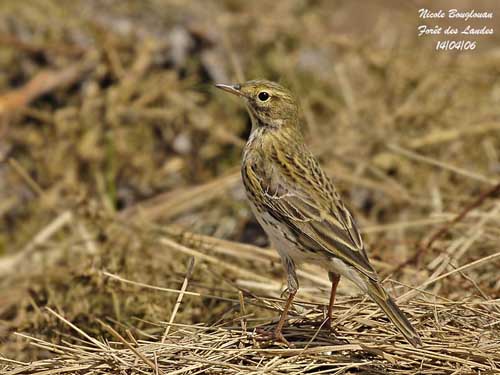
Meadow Pipit
Anthus pratensis
Passeriforme Order – Motacillidae Family
BIOMETRICS:
Length: 14-15 cm
Wingspan: 22-25 cm
Weight: 18,5-19,5 g
DESCRIPTION:
The Meadow Pipit is a widespread species of the open habitats. Its cryptic plumage melts into the vegetation, but its terrestrial habits make it sometimes conspicuous when running on the ground like a mouse!
The Meadow Pipit has brown or olive-brown upperparts, broadly streaked brownish-black on head, mantle, scapulars and back. The upperwing is darker with paler edges on flight feathers, whereas tertials and upperwing-coverts show pale olive or whitish edges, forming two wingbars. The tail is dark brown with greenish-olive fringes on central pair, and whitish outer webs on outermost pair.
Underparts are paler, whitish to greyish, or yellowish-buff. Throat side, breast and flanks are broadly streaked dark. On the underwing, coverts and axillaries are buffy-white.
Fr: Pipit farlouse
All : Wiesenpieper
Esp : Bisbita Pratense
Ital : Pispola
Nd: Graspieper
Sd: Ängspiplärka
Text and photographs by Nicole Bouglouan
Sources :
HANDBOOK OF THE BIRDS OF THE WORLD Vol 9 - by Josep del Hoyo - Andrew Elliot - David Christie - Lynx Edicions - ISBN: 8487334695
THE HANDBOOK OF BIRD IDENTIFICATION FOR EUROPE AND THE WESTERN PALEARCTIC by Mark Beaman, Steve Madge - C.Helm - ISBN: 0713639601
THE COMPLETE BOOK OF BRITISH BIRDS – Written by “Royal Society for the Protection of Birds” experts - Préface de Magnus Magnusson - Michael Cady- Rob Hume Editors - ISBN: 0749509112
ENCYCLOPEDIE DES OISEAUX DE FRANCE ET D’EUROPE – de Peter Hayman et Rob Hume - Flammarion – ISBN : 2082009920
BirdLife International (BirdLife International)
Wikipedia, the free encyclopaedia

On the head, crown is like upperparts. Ear-coverts are brown or yellowish-brown, and there is a narrow blackish malar stripe.
The slender bill is dark brown with paler base of lower mandible. The eyes are blackish-brown, surrounded by pale eyering. Legs and feet are yellowish-brown, with long hind claw.
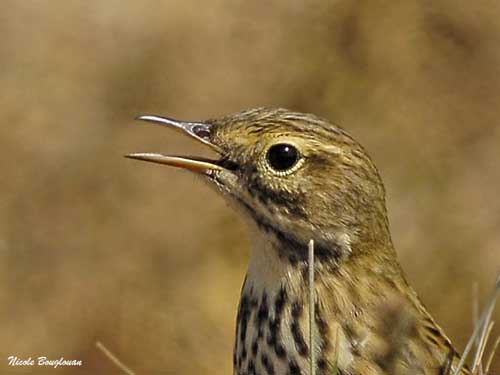
Both sexes are similar.
The juvenile has more buff-brown upperparts with conspicuous streaking and pale underparts with weak streaks on flanks.
The subspecies A.p. whistleri from N Scotland and Ireland has stronger markings with heavier streaks on back and deeper rufescent olive-brown upperparts.
VOICE: SOUNDS BY XENO-CANTO
The Meadow Pipit gives territorial calls while flying.
The song is a series of several segments of uniform notes such as “tsip”, “tyie”, “tchip”, “zu” and “tlip”. This song starts quietly, then becoming louder, faster and higher pitched, and ending in flourish “tee-swia-swia”.
When the bird sings from the ground, we can hear repeated “tsip” or “zi” notes.
The call is thin and high-pitched, “psiip” or “isst” often repeated. The alarm call is louder. The contact call is a “chutt” or “chitt”, and it utters some “sitt-it” when excited.
HABITAT:
The Meadow Pipit frequents open habitats of various types such as tundra, moorland, heathland, saltmarshes, dunes, coastal meadows and forest clearing. It is found in the same variety of habitats during winter, and it also occurs along the seashores.
It breeds from sea-level to 3000 metres of elevation, but mainly between 800 and 1600 metres in the southern parts of the range.
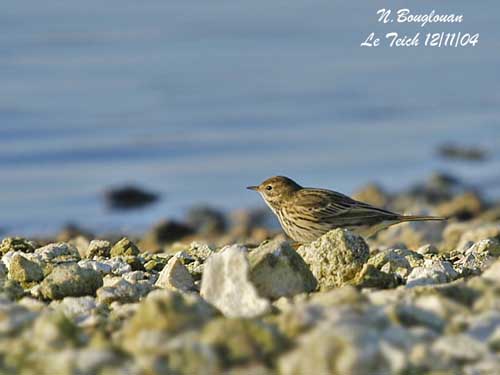
RANGE:
The Meadow Pipit breeds in most of the northern half of Europe and in NW Asia, from Greenland and Iceland, E to east of Ural Mountains in Russia, and S to central France and Romania.
The race “whistleri” is found in N Scotland and Ireland.
The Meadow Pipit is mainly resident or partial migrant in W Europe, where the species performs locally some altitudinal movements in winter. The northernmost populations from Greenland and Iceland reach W Europe to winter. The populations of N and E are medium-distance migrants and move according to the weather conditions. The W Siberian breeders migrate to SW Asia.
BEHAVIOUR:
The Meadow Pipit is mainly terrestrial when foraging for food in the short vegetation. It walks and runs while picking preys from the ground and the vegetation. It may occasionally catch a flying insect, but aerial pursuits are rare. However, it also wades in shallow water.
During the non-breeding season and the stopovers, they may gather in small or larger flocks.
The Meadow Pipit feeds on small invertebrates such as numerous insects, spiders, snails and worms. It also consumes seeds in autumn and winter.
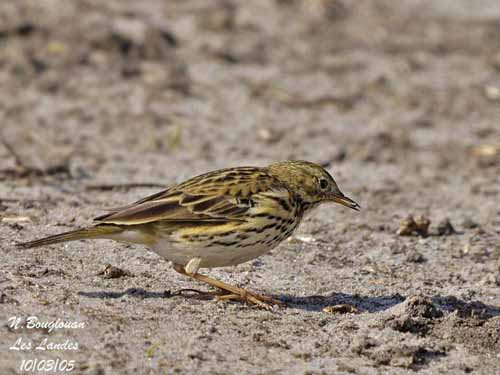
At the beginning of the breeding season, the male performs beautiful flight displays. The bird takes off from a perch and rises up to 20 metres with a fluttering flight. Then, it descends with half-spread wings and slightly raised tail, parachuting downwards. This display is accompanied by song.
This species is territorial and monogamous.
FLIGHT:
The Meadow Pipit has rounded wings. It performs an undulating flight. The flight displays are spectacular and accompanied by song.
REPRODUCTION:
The breeding season occurs from April to August in C and W Europe, and later at high elevations. This species may produce two broods, occasionally three.
The nest is well concealed in vegetation on the ground, usually in open area, on heaths or in coastal marshes. The female builds the nest with grass, and the neat cup is lined with finer grass and hair.
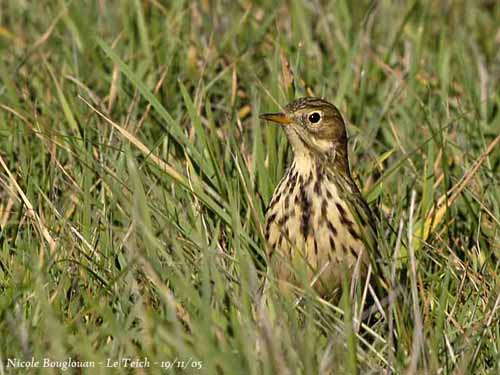
She lays 2-7 glossy white eggs with brown spots. She incubates alone during 13 days, but the male may assist occasionally.
The chicks are fed by both parents, and leave the nest between 10 and 14 days after hatching, before to be able to fly. They still depend on parents for about two weeks more after fledging.
The nest of the Meadow Pipit is often parasitized by the Common Cuckoo.
DIET:
The Meadow Pipit feeds mainly on invertebrates such as insects, flies, spiders, moths and beetles. It also takes seeds in autumn and winter. It is terrestrial and forages among the short vegetation on the ground.
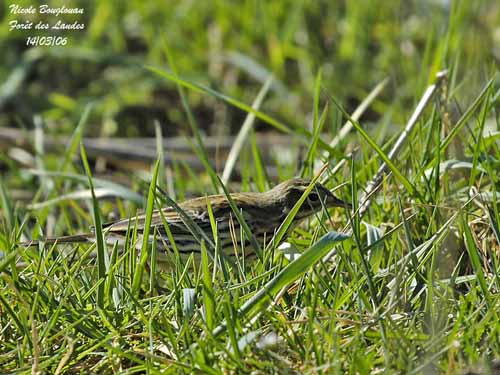
PROTECTION / THREATS / STATUS:
The Meadow Pipit is usually common or even very common in its range. Some local declines could be caused by agriculture intensification and degradation of forest.
This species is heavily preyed upon by Merlins and Hen Harriers.
However, the Meadow Pipit’s populations are not currently threatened.
